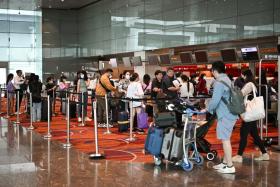Warm up to 'world's coolest safety video' from Air New Zealand
Airline's latest in-flight safety video shot in Antarctica focuses on tackling climate change
Air New Zealand is well-known for its creative in-flight safety videos, from a tribute to Tolkien's Middle-Earth to celebrity adventurer Bear Grylls exploring the country's Great Walks network.
This year, the airline has gone one step further with its "World's Coolest Safety Video", released on March 1.
Shot in Antarctica, its latest offering showcases grand landscapes and the important climate and environmental research done there.
Featuring US actor Adrian Grenier, of Entourage fame, a UN Environment Goodwill Ambassador, it takes viewers on a breathtaking journey to the frozen continent, where Kiwi scientists are tackling the most pressing questions on global climate change.
According to Air New Zealand's head of sustainability Lisa Daniell, the airline has supported scientific research in Antarctica for close to a decade, enabling new climate science and environmental projects to take place.
She told The New Paper: "Our safety videos attract worldwide attention and we saw an opportunity to use this unique platform to share an important sustainability message with millions, highlighting Antarctica's vulnerability and the importance of research to understanding and planning for global climate change."
Shooting in freezing conditions posed unique challenges for the film crew.
"Along with adapting to working and living in extreme conditions, it was incredibly important to us that we take all possible steps to minimise the environmental impact of filming," she said.
For example, a team of just six with minimal filming equipment travelled to Antarctica - a far cry from the 40 to 50 people involved in previous safety videos.
The video was shot at Scott Base, New Zealand's Antarctic research station run by Antarctica New Zealand, an institute managing New Zealand's interests in Antarctica and the Ross Sea.
In 2012, Air New Zealand established a formal support agreement with Antarctica New Zealand and the New Zealand Antarctic Research Institute to enable field research led by New Zealand science teams to understand the future implications of climate change.
Air New Zealand also works with the Department of Conservation (DOC) on projects in New Zealand's national parks to protect native ecosystems, transfer endangered species to new breeding grounds and more.
Ms Daniell said: "There is a growing trend internationally towards sustainable travel. As New Zealand's largest tourism business, we're aware of our responsibility to ensure we grow our tourism industry in a way that represents true sustainable development."
To reduce its carbon footprint, the airline revamped its customer offset programme last year to make it more prominent.
Since the revamp, thousands of customers have elected to offset the carbon impact of their journeys, with their contributions going directly to native forest offsetting projects in New Zealand.
She added: "One of the most significant ways to reduce emissions is by operating a modern and efficient fleet. We were the first airline to take delivery of the revolutionary 787-9 Dreamliner in 2014 and we retired our last Boeing 767 aircraft from our fleet in 2017.
"Over the next four years, we plan to invest approximately NZD$1.5 billion (S$1.44 billion) in new and more efficient aircraft."
For eco-tourists looking at New Zealand, Ms Daniell recommends the DOC's extensive network of Short Walks, Day Walks and the multi-day Great Walks.
Exploring less-visited regions is another way for tourists to share the economic benefits of their trip with more Kiwi communities, she added.
Get The New Paper on your phone with the free TNP app. Download from the Apple App Store or Google Play Store now



